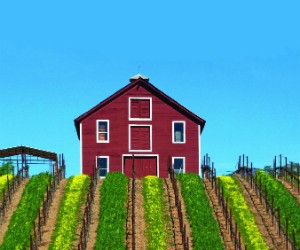It’s been six months since the wildfires in Sonoma and Napa counties were extinguished, and the message from locals to planners is clear: Spring is in the air, and it’s business as usual in Wine Country—as beautiful and bucolic as ever.
“There are a number of myths still circulating, mostly that the majority of the county burned, but in reality, 95 percent of Sonoma was unaffected by the fires, and the wineries, the coastal communities, the incredible small towns and the wonderful outdoor recreation has never been better,” said Claudia del Vecchio, president and CEO of Sonoma County Tourism. “The mustard has bloomed, and we’re starting to see barrel tastings now. It’s a time when Sonoma comes to life after winter and particularly symbolic this year—spring signals a new time and a time to move forward.”
Napa is also moving forward, having just recorded a significant increase in January 2018 arrivals over the previous years, grateful for the support it has received from visitors.
“Because the October wildfires burned predominantly in the forested hillsides, the well-known Napa Valley floor, located between Highway 29 and the Silverado Trail, saw little to no impact,” said Clay Gregory, president and CEO of Visit Napa Valley.
While some wineries in the region were damaged and two hotels in Sonoma were decimated, Wine Country was largely unscathed. Yet the fires were the deadliest in California history—at least 42 people died and thousands of buildings burned to the ground, mostly residences.
Gregory and others in the tourism industry said the best way for wine enthusiasts, meeting attendees included, to help their communities recover is to visit and support their hotels, restaurants and tasting rooms.
And they have. Like neighbors helping neighbors after the fires, the meetings and conventions industry has also stepped in to lend a hand through The Fire Relief Incentive, in which groups had to book and actualize the meeting on or before May 31, 2018, and the hotel booked woud donate amounts varying from $500 to $3,000. To date, 16 meetings have booked under the incentive.
As of April 1, 2018, meeting planners had given $22,500 to the fire relief efforts through hotel donations.
“Beyond the support we’ve seen from planners bringing groups to the region to help the industry recover, another trend has been groups wishing to include a volunteer activity in their agenda to give back to the community,” del Vecchio said. “We’ve had several groups participate in activities with organizations such as the Redwood Food Bank. Whether it’s putting together care packages or cleaning up some of the burned area, they want to help, which has been nice to see.”
As wineries and hotels continue to reopen throughout Sonoma and Napa counties, groups will find the region’s trademark hospitality and a wealth of new offerings. Following is an update for both regions.
Sonoma Group Venues Bounce Back
One winery, Paradise Ridge in Santa Rosa, was mostly destroyed.
The winery has a tasting room in Kenwood, which is open to guests. While the tasting room in Santa Rosa was affected, the popular sculpture garden and the famous Love statue survived. The Byck family, the owners of Paradise Ridge, are planning to open their grounds in the coming year for tastings and events.
Meanwhile, less than 100 vineyard acres were lost in the fires, out of more than 60,000 total acres planted to grapes. Sonoma County itself is 1 million acres in size.
On the hotel front, three hotels in Santa Rosa burned down in the fires: Hilton Sonoma Wine Country, Fountain Grove Inn and Americas Best Value Inn & Suites.
However, Sonoma County is experiencing a hotel boom, with the recent newcomers including the Oxford Inn & Suites in Rohnert Park and Holiday Inn Windsor Wine Country. This year, two properties will reopen after expansion projects: Hyatt Vineyard Creek and Vintners Inn, both in Santa Rosa.
Five other new hotels have been approved and will open over the next few years, including Cambria Hotel and Suites in Rohnert Park and Old Courthouse Square Hotel in Santa Rosa, both scheduled for the first quarter of 2019.
Napa Meetings Business Holds Steady
The majority of Napa Valley’s more than 400 wineries were open and hosting guests just days after the fires started, and only a small number of wineries in Napa Valley were severely affected by the fires.
No hotels in Napa County burned.
Fewer than 10 percent of Visit Napa’s 550 winery members reported direct damage from the fires and much of that was relatively minor. Of the 10 wineries that experienced extensive damage, most were not open to the public or have made other arrangements to receive guests while they rebuild.
Nearly all the region’s wineries are open and eager to welcome visitors and groups.
“The message is same as 10 days after the fires: the world-renowned Napa Valley floor from Yountville to St. Helena and beyond has not been affected at all,” said Teresa Savage, director of sales for Visit Napa Valley.
Meanwhile, the destination has also been busy with hotel openings and upgrades. Recent newcomers include the boutique Archer Hotel in downtown Napa, which will debut its new rooftop patio in June 2018, while the upscale Vista Collina Resort is scheduled to open in July 2018 across the street from The Meritage Resort & Spa.
In 2019, Four Seasons Calistoga will be unveiled across from Solage Calistoga, significantly elevating the experience for groups in the destination.
On the food front, the Culinary Institute of America is in the process of opening a test kitchen on the Copia campus in downtown Napa, which has been a favorite for group events and classes since it reopened in 2016 as a center for wine and food, Savage said.
Next door, Oxbow Public Market is still all the rage with groups meeting in the destination, Savage added.







